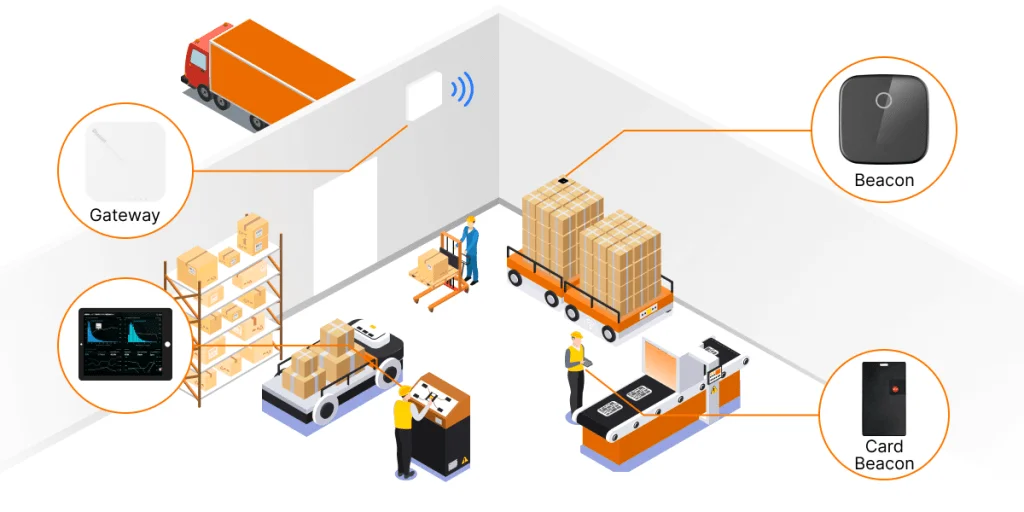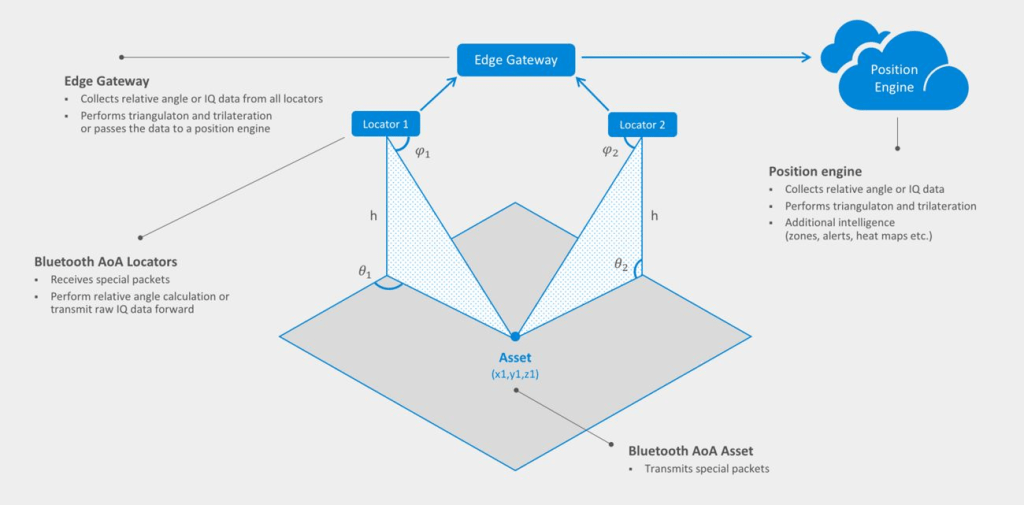Asset tracking plays an increasingly important role, mainly relying on indoor positioning and navigation technology. Three popular indoor positioning technologies are most suitable for asset tracking: Bluetooth RSSI, BLE AOA Positioning, and UWB Positioning. People may be perplexed or unsure of what indoor positioning technologies are when looking for them. This article tries to explain the distinctions and assist you in selecting a superior indoor positioning method.

Bluetooth RSSI
What is Bluetooth RSSI?
Bluetooth RSSI positioning determines location based on the connection between signal strength and distance. Because the connection between signal intensity and distance is non-linear, and signal strength is affected by various factors (such as occlusion, different directions, different broadcast channels, and so on), positioning accuracy is low.
Bluetooth RSSI positioning is classified into two methods: regional positioning and triangular positioning. The Bluetooth beacon + Bluetooth gateway approach can achieve regional placement, and the Bluetooth beacon + Bluetooth work card + Bluetooth gateway technique can achieve triangulation. It is sent to the Bluetooth gateway, which then sends the data to the server for location calculation.
Bluetooth RSSI positioning is based on trilateration, which smoothes fluctuating RSSI by averaging (or signal processing) various RSSI readings across time. Unknown directions can be resolved using trilateration, which involves using three gates to calculate distances to three directions and thus 2D placements.
There are two types of RSSI positioning. The first scenario involves the gateway being in a known position while the beacon moves. The second is where the beacon remains stationary while the detector travels. In any case, the gateway receives a unique beacon ID, and the receiving electronics supply the signal strength. The RSSI value can be used to calculate the distance between the detector and the beacon.
You maybe also interested in What is a Bluetooth Gateway?
How to improve Bluetooth RSSI Positioning accuracy
By taking an accurate measurement of the RSSI at a specific location and calibrating the device appropriately, the aforementioned physical elements that affect RSSI can be diminished. When the beacon is nearer the detector, the RSSI fluctuates greater with distance at the same time.
It is challenging to determine whether a change in RSSI at the beacon signal’s edge is the result of distance change or radio noise because the RSSI fluctuates so little with distance there. So, for a system utilising signal processing, trilateration, and calibration, you can often attain an accuracy of around 1.5 metres in small spaces at shorter ranges, and about 5 metres at longer ranges.

Major challenge of RSSI
The fundamental issue with RSSI is that it fluctuates far too much over time to be used for precise distance measurements. The direction is likewise unknown when there is only one beacon and one detector. RSSI changes occur even while nothing is moving because Bluetooth radio signals are reflected by physical impediments, deflected, and interfered with by other devices using identical radio frequencies.
Rooms, beacons that do not transmit equally throughout 360 degrees, walls, other objects, and even humans can all have an impact on the received signal strength. The way the user holds the detecting phone can alter the antenna’s efficacy and consequently the signal strength.
UWB Positioning
What is UWB Positioning?
UWB is a communication medium that distributes information across a broad frequency band. This enables UWB location transmitters to send enormous volumes of data while using minimal transmit energy. The distance between the reference point and the target is calculated using the time difference of arrival (TDOA) or the RF signals in UWB positioning.
UWB location systems rely on extremely brief pulses and approaches that cause radio energy to spread (over a wide frequency range) with a very low power spectral density. Its high data throughput allows for fast communication. Because UWB pulses have a low frequency, they may efficiently travel through ordinary items such as falls, furniture, and other objects.
UWB provides your gadgets a sixth sense. These signals operate on a range of spatial scales, from NANO to Personal Area Network (PAN). Because of its low pass spectral density, UWB works in close proximity and over a wide bandwidth by design. The UWB connects with peer devices using the 802.16.5 protocol.
The UWB uses pulse radio to broadcast a wide bandwidth in short cycles while requiring minimal power. By broadcasting more pulses per second, UWB increases localization accuracy and data speeds by using high pulse repetition rates.
Major challenge of UWB Positioning
Although UWB positioning systems offer numerous advantages, they also have certain disadvantages. Misconfiguration, for example, might interfere with neighbouring devices running in the ultra-wide spectrum. The UWB frequency range for communication applications in the United States is the same as the operational frequency of many common communication products.
As a result, UWB systems may cause severe interference to some systems and services. Additionally, simultaneous ranging among many UWB tags may cause issues with channel access management. As a result, UWB positioning accuracy is often lowered. Although employing very brief pulses in UWB has several advantages, UWB receivers require signal capture, synchronisation, and tracking. Timing accuracy is relatively good relative to pulse rate. These stages take a long time.
BLE AOA
What is BLE AOA?
A tag or smartphone—or pretty much anything with a Bluetooth transmitter—can be tracked depending on its position using a network-centric approach to AoA. Devices provide their location to location services apps by transmitting direction-finding-enabled packets through a single aerial. The locator receives the radio signal and estimates the angle. Lastly, the data is delivered to the location engine, which calculates location information and delivers the specific position of the device.
BLE AoA is a strong option for most industrial and corporate use cases since intelligence is integrated into the network rather than the device. Asset monitoring and security applications in manufacturing, oil and gas, and other industrial industries, as well as productivity use cases in smart buildings and smart hospitals, are already using AoA-based systems.
Major challenge of BLE AOA
The positioning range of BLE AOA Solution is limited, and multiple IoT gateways are required when the scene is relatively large. In addition, the AOA gateway can only be installed on the ceiling, which limits its application.
BLE AOA Vs BLE RSSI Vs UWB
The most crucial factor to consider when selecting a positioning technology is positioning accuracy. In general, the higher the precision, the higher the expense, and the more complicated the system. The technology utilised in an asset tracking system is influenced by location accuracy. The key element to remember is that when combined with direction finding, Bluetooth AoA technology may achieve great accuracy at a lower cost than other indoor positioning methods.
As a result, AOA technology is preferred and widely employed in cold chain monitoring, warehouse asset tracking, medicinal, and construction areas.
Dusun IoT has proposed a mature BLE AOA solution for various asset locating application scenarios. If you have an on-site layout that requires asset positioning, please submit it to us. We will assist you with drawing out the BLE AOA construction site map and creating a bespoke plan for you.





















